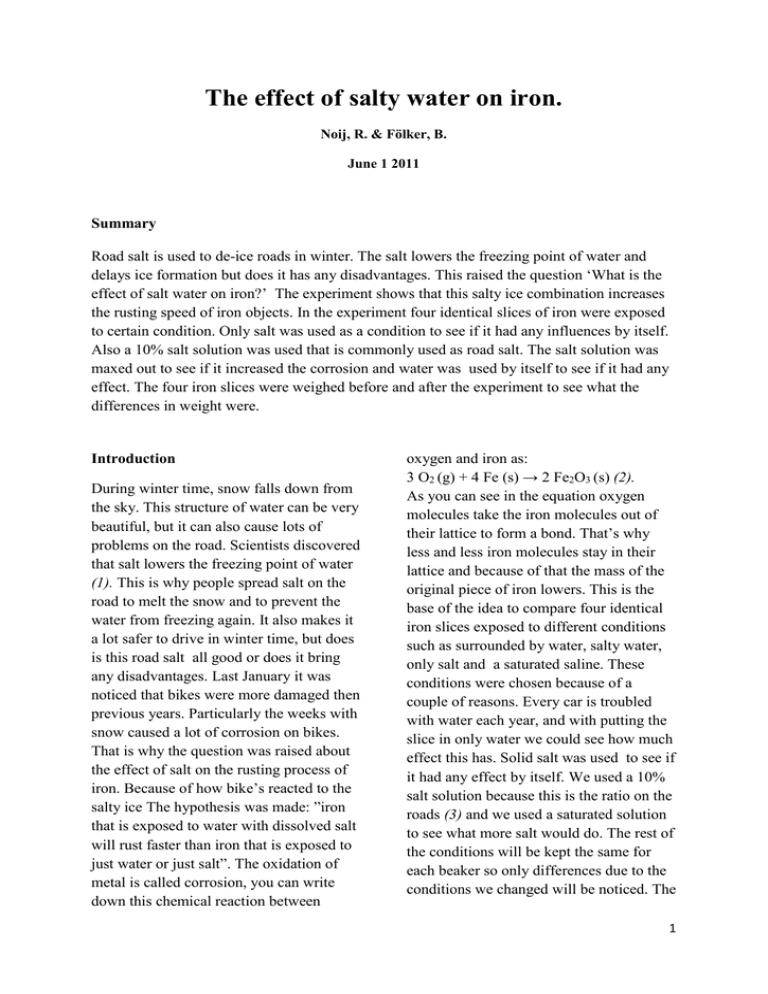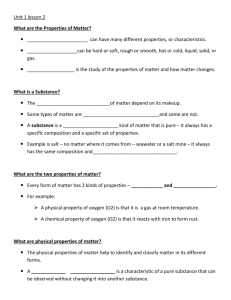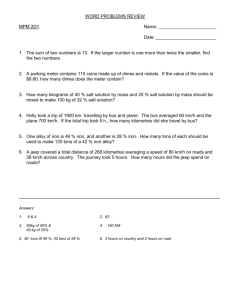The effect of salty water on iron.
advertisement

The effect of salty water on iron. Noij, R. & Fölker, B. June 1 2011 Summary Road salt is used to de-ice roads in winter. The salt lowers the freezing point of water and delays ice formation but does it has any disadvantages. This raised the question ‘What is the effect of salt water on iron?’ The experiment shows that this salty ice combination increases the rusting speed of iron objects. In the experiment four identical slices of iron were exposed to certain condition. Only salt was used as a condition to see if it had any influences by itself. Also a 10% salt solution was used that is commonly used as road salt. The salt solution was maxed out to see if it increased the corrosion and water was used by itself to see if it had any effect. The four iron slices were weighed before and after the experiment to see what the differences in weight were. Introduction During winter time, snow falls down from the sky. This structure of water can be very beautiful, but it can also cause lots of problems on the road. Scientists discovered that salt lowers the freezing point of water (1). This is why people spread salt on the road to melt the snow and to prevent the water from freezing again. It also makes it a lot safer to drive in winter time, but does is this road salt all good or does it bring any disadvantages. Last January it was noticed that bikes were more damaged then previous years. Particularly the weeks with snow caused a lot of corrosion on bikes. That is why the question was raised about the effect of salt on the rusting process of iron. Because of how bike’s reacted to the salty ice The hypothesis was made: ”iron that is exposed to water with dissolved salt will rust faster than iron that is exposed to just water or just salt”. The oxidation of metal is called corrosion, you can write down this chemical reaction between oxygen and iron as: 3 O2 (g) + 4 Fe (s) → 2 Fe2O3 (s) (2). As you can see in the equation oxygen molecules take the iron molecules out of their lattice to form a bond. That’s why less and less iron molecules stay in their lattice and because of that the mass of the original piece of iron lowers. This is the base of the idea to compare four identical iron slices exposed to different conditions such as surrounded by water, salty water, only salt and a saturated saline. These conditions were chosen because of a couple of reasons. Every car is troubled with water each year, and with putting the slice in only water we could see how much effect this has. Solid salt was used to see if it had any effect by itself. We used a 10% salt solution because this is the ratio on the roads (3) and we used a saturated solution to see what more salt would do. The rest of the conditions will be kept the same for each beaker so only differences due to the conditions we changed will be noticed. The 1 temperature at which the experiments will take place is 1 °C to imitate the conditions of winter as much as we can without freezing the water. The salt that is used in the experiment is NaCl (s) because that is the most common road salt. The iron slices are weighed before and after the experiment and compared these results with each other. The prediction is that if salty water causes iron to rust faster, then the difference in weight, before and after the experiment, of the iron slice that is exposed to salty water will be bigger than the difference in weight, before and after the experiment, of the iron slice exposed to just water. - - Materials - Four beakers of 500 mL Four slices of iron from 40 cm x 10 cm x 1,0 cm About 1500 mL of demi-water About 400 gram of NaCl (s) Scales Stirring tool Marker - Method - - - so that each iron slice is completely surrounded by water/salty water/salt. Mark each beaker with a number from one till four. Put four of the same iron slices in each beaker and make sure that it’s diagonal in it so the contact surface is optimal. Put the four beakers in the refrigerator at a temperature of 1 °C and first wait for two days. Take a look at the four different beakers and write down the differences you can see. Take a picture off the beakers. After this wait for a week and a half. After a week and a half get the four beakers out of the refrigerator. First write down the differences you can spot between the four beakers and take a picture of every beaker. Take the four iron slices out of the beakers and take a picture of them as well. Wash all of the rust of the iron slices and dry them. Make sure you still know which one belongs to which beaker. Weigh the iron slices again and write your figures down in a table. Take the four iron slices and weigh them. Write the masses of each iron slice down in a table. Take the four beakers. Fill the first one with demi-water, the second one with NaCl (s), the third one with a 10 volume % of NaCl (s) in water and the fourth one with a saturated saline of 360 g NaCl (s)/L. Make sure that each beaker is filled enough with water/salty water/salt 2 Results After two days the experiment was checked and observed (Fig. 1). The most corrosion was detected on the iron slice in beaker 3 with the 10 volume % of NaCl (s). After that the iron slice in beaker 1 with demi-water had the most rust , no rust had formed on the iron slice of beaker 2 with NaCl (s). In beaker 4 ( with the saturated salt saline) no rust was detected on the iron slice as well. to get off (Fig. 3). Table 1 shows the masses of the iron slices that we found before the experiment and after the experiment. Figure 2: Beakers after 12 days Figure 1: Beakers after 2 days 12 days after we started the experiment we finally checked it to gather the results (Fig. 2 and 3). Beakers one till three showed not much of a difference with our first check. Beaker two still didn’t show any corrosion Beaker one and three showed more corrosion and the third beaker still showed the most. In both beaker 1 and 3 rust had deposited on the bottom of the beaker. In beaker four the situation had changed drastically. Some kind of salty crust of about 1 cm had formed on the edges of the beaker. The iron slice in the beaker now was corroded and there was also rust on and around the bottom of the beaker. There was not just rust on the iron slice but a crust of rust and solid salt had formed on the surface of the iron slice that was hard Figure 3: Iron slices after 12 days Number of beaker slice of iron was in. 1 2 3 4 Mass Mass after before Difference. experiment. experiment. 329,00 g 328,93 g 0,07 g 328,50 g 328,47 g 0,03 g 328,60 g 328,36 g 0,24 g 329,70 g 329,60 g 0,10 g Table 1: Mass (g) of the different slices of iron before and after the experiment. 3 Conclusion Based on the results of the experiment and the observations we did regarding these experiments, we can conclude that dissolved NaCl speeds up the process of rusting. The hypothesis that iron exposed to water with dissolved salt will rust faster than iron exposed to just water is hereby confirmed, because the difference in weight, before and after the experiment, of the iron slice that is exposed to salty water will be bigger than the difference in weight, before and after the experiment, of the iron slice exposed to just water. Experiment two shows that only dissolved NaCl speeds up the process of corrosion and NaCl (s) doesn’t, because we didn’t see any corrosion. No sensible conclusion can be drawn from experiment four. The results of the experiments didn’t differ that much. The masses of each of the iron slices were in the beginning almost identical to the masses at the end of the experiment. This is what makes the inquiry less reliable. The conclusion is though still right because the observations were clear. To make this inquiry more reliable thinner slices of iron could be used in a following experiment. The surface of the slices will pretty much remain the same whereas the mass of the iron slice will be much less. This causes the percentage of mass of the iron slice that is used for corrosion will be higher and by that the experiment will be more reliable. Experiment four was done to check if more dissolved NaCl would speed up the process of corrosion. It turned out afterwards that O2 (g), which is required for corrosion, couldn’t dissolve anymore because of saturated saline. That could explain what was observed during the first check. The slice of iron didn’t corrode and because the O2 (g) couldn’t reach it. In the time that the beakers were in the refrigerator the water could still evaporate a little bit at 1 °C and therefore crystallization could take place on the edges of the beaker forming a crust. This means that there is room again for O2 (g) because part of the dissolved NaCl is out of the saline. Because of this corrosion can take place again. That might be the reason why there was rust in the beaker when we checked for the second time. It was also weird that a crust of NaCl (s) and rust had formed on the iron slice of experiment four. The crust prevented the iron slice from corroding any further and that’s not fair compared to the other experiments. To prevent all that happened in the fourth experiment a less saturated saline could be used in a following experiment. To draw a sensible conclusion in a following experiment a for example 50 volume % NaCl saline could be used. The conclusion drawn from experiment 2 might be invalid because no control experiment was done with regard to this experiment. You should have compared the iron slice in beaker 2 to an iron slice exposed to the air. Our conclusion drawn from experiment 2 is however though valid because half of the iron slice was exposed to air and half of the iron slice was exposed to NaCl (s). No differences were found between these two halves and that’s why NaCl (s) has no effect. During this inquiry a couple questions remained unanswered. We don’t know if only dissolved NaCl speeds up the process of corrosion. Other salts might too and they might even work better. We also don’t know if only the oxidation of iron is catalysed by salt. Other metals might corrode faster or might form a layer that oxygen can’t fit through as we thought we saw in experiment four. Whatever the case 4 may be, using salt on roads not only brings advantages but it also carries disadvantages such as corrosion but there might be other negative effects on for example the growing of plants. That’s why we need to come up with more ideas and test different types of salts to solve these problems and make the roads saver and happier again. References (1), (3) Iru, P et al. (2011). Journal of Anorgano chemistry. Vrije Universiteit Amsterdam. (2) Wikipedia: the free encyclopedia, Redox. http://en.wikipedia.org/wiki/Redox 5







